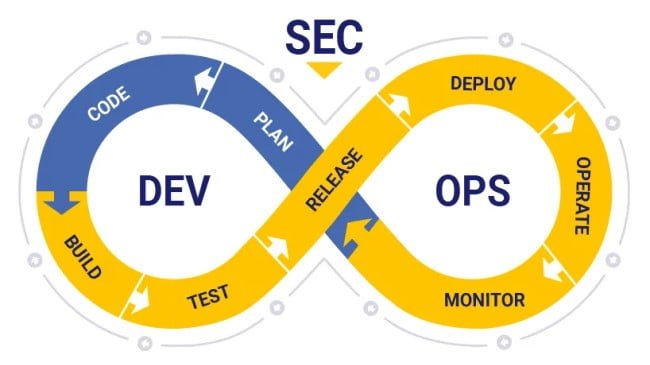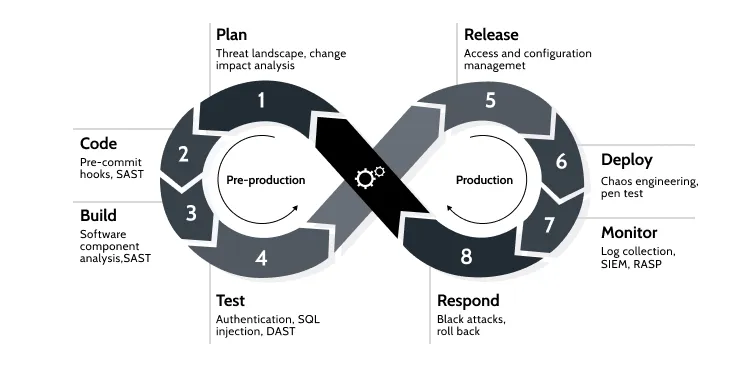
DevSecOps Definition
DevSecOps is an acronym for development, security and operations. Its purpose is to ensure that everyone is responsible for security so that security decisions and actions are implemented at the same scale and speed as development and operations decisions and actions.
Every organization with a DevOps framework should move to a DevSecOps mindset and ensure that everyone with different skills and across different technological disciplines has a higher competency in security. From testing for potential vulnerabilities to building business-driven security services, a DevSecOps framework using DevSecOps tools ensures that security is built into all applications from the beginning, rather than being randomly added later.
When we ensure that security is present at every stage of the software development lifecycle, we create an environment of continuous integration where the cost of compliance is reduced and software is developed and delivered faster.
How does DevSecOps work?
The benefits of DevSecOps are simple: Improved automation in the software development pipeline eliminates errors and reduces attacks and downtime. For teams looking to integrate security into their DevOps framework, this can be accomplished seamlessly using the right DevSecOps tools and processes.
Let’s examine a typical DevOps and DevSecOps workflow:
- A developer produces code within a version control management system.
- Changes are entered into the version control management system.
- Another developer retrieves the code from the version control management system and analyzes the static code to identify vulnerabilities or errors in code quality.
- An environment is then created using an infrastructure-as-code tool such as Chef. The application is deployed and security configurations are applied to the system.
- Then, this newly deployed application is put through a test automation suite, including backend, UI, integration, security tests and API.
- If the application passes these tests, it is deployed to a production environment.
- This new production environment is continuously monitored to detect any active security threats the system may face.
- When a test-driven development environment is in place and automated testing and continuous integration are part of the workflow, organizations can more smoothly and quickly achieve their common goal of improving code quality, security and compliance.
Why do we need DevSecOps?

IT infrastructures have undergone massive changes over the last decade. The move to agile cloud computing platforms, shared storage and data, and dynamic applications have brought enormous benefits to organizations looking to evolve and grow using advanced applications and services.
However, while DevOps practices led the way in speed, scale and functionality, they often lacked strong security and compliance. Therefore, DevSecOps was introduced into the software development lifecycle to unify development, operations and security under one umbrella.
Hackers are constantly looking for the best ways to deploy malware and other unauthorized access tools. Imagine if they were able to inject malware into an application during the development process and that malware was not discovered until that application was deployed to thousands of customers. This would cause terrible damage to customers’ systems and the company’s reputation, especially in a world where bad news can go viral in minutes.
Viewing and addressing security on an equal footing with development and operations is a must for any organization involved in application development and deployment. When you integrate DevSecOps and DevOps, every developer and network administrator will prioritize security when developing and deploying applications.
DevSecOps Best Practices
Organizations looking to unify IT operations, security teams and application developers need to integrate security into their DevOps processes. The goal is to make security a core component of the software development workflow, rather than implementing it later in the cycle.
Here are some of the best practices to ensure that the DevSecOps process runs smoothly:
Automation is good
DevOps is all about speed of development and delivery, and with security built into the process, that speed doesn’t have to be compromised. By incorporating automated security checks and testing early in the development cycle, you can ensure that your applications are developed quickly.
Using DevSecOps for efficiency
You’re just adding security to your workflows. When you use tools that scan code as it’s written, you can discover security issues early on.
Threat modeling
Threat modeling exercises can help you discover the vulnerabilities of your assets and close gaps in security controls. Forcepoint’s Dynamic Data Protection solution can help you identify the most risky events happening in your infrastructure and incorporate the necessary protection into your DevSecOps workflows.
While there is a consensus on what DevSecOps means for businesses, its value is easy to understand in a world of rapid development cycles, evolving security threats and continuous integration.